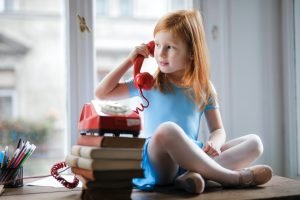From the moment a child takes their first breath to the age of 3, is when their brains develop the fastest within their lifetime.
They’re sponges ready to acquire any information we give them.
But teaching any toddlers different skillsets is difficult. It’s a “you have to compromise” kind of relationship, where they tell us, “Be patient with us AND we’ll learn it if we find it to be in our best interest.”
When it comes to ABC’s, an ABC chart isn’t going to be enough. Toddlers learn well by listening in music form, interacting/engaging, and constant repetition. A child needs to be stimulated with lots of different ways to play and learn. This is why it’s important that we look into alphabet toys for toddlers.
Alphabet toys that are more visually appealing and audio friendly peaks a child’s interest. Having fun while learning is the recipe for teaching your little one anything (and probably for every living being).
While using alphabet toys to help teach your little one, parents/caretaker’s involvement is vital. Babies and toddlers learn from an engaged and responsive relationship.
But don’t feel pressured to force them to learn the alphabet. Every child will go at their own pace. Make ABC learning an activity, like you would with any playtime activity.
When our daughter was 2 years and 2 months old, she was able to sing the ABCs herself and point to most of the letters that we asked. We didn’t force anything; we treated the ABCs like a playtime activity that’s part of a daily routine.
What helped a lot is that the alphabets are everywhere around the house, therefore having multiple reminders of the letters she’s learned. Whether she’s hanging out at the kitchen, her play table, her collection of toys, or bedroom, her alphabets are all there.
The Science of Teaching the Alphabet
According to raisingchildren.net:
Your child learns best by actively engaging with her environment. This includes:
- observing things, watching faces and responding to voices
- listening to sounds, making sounds and singing
- exploring – for example, putting things in her mouth, shaking things and turning things around
- asking questions – for example, ‘But why?’
- experimenting with textures, objects and materials like water, sand or dirt
- doing things that stimulate all of her senses – touch, taste, smell, vision and hearing
Your child also learns by being involved in his learning. This could be as simple as:
- choosing books to read
- pointing to pictures in books
- choosing objects and toys to play with
- picking out vegetables for dinner
- measuring out flour for muffins
With ABCs, alphabet toys are important because it enables lots of different activities. Children learn best when given different ways to learn, practice, and apply. Regarding alphabets, they can read a book, sing the ABCs, or write out letters in chalk.
What Age Should They Begin Learning?
According to understood.org:
By age 2: Kids start recognizing some letters and can sing or say aloud the “ABC” song.
By age 3: Kids may recognize about half the letters in the alphabet and start to connect letters to their sounds. (Like s makes the /s/ sound.)
By age 4: Kids often know all the letters of the alphabet and their correct order.
By kindergarten: Most kids can match each letter to the sound it makes.
Research has shown that knowing ABCs can range from age 2-6. Every child differs in there readiness with academia. There’s no need to purposely try to drill the alphabets into your little one’s head. They’re absorbing information and processing it in their own way.
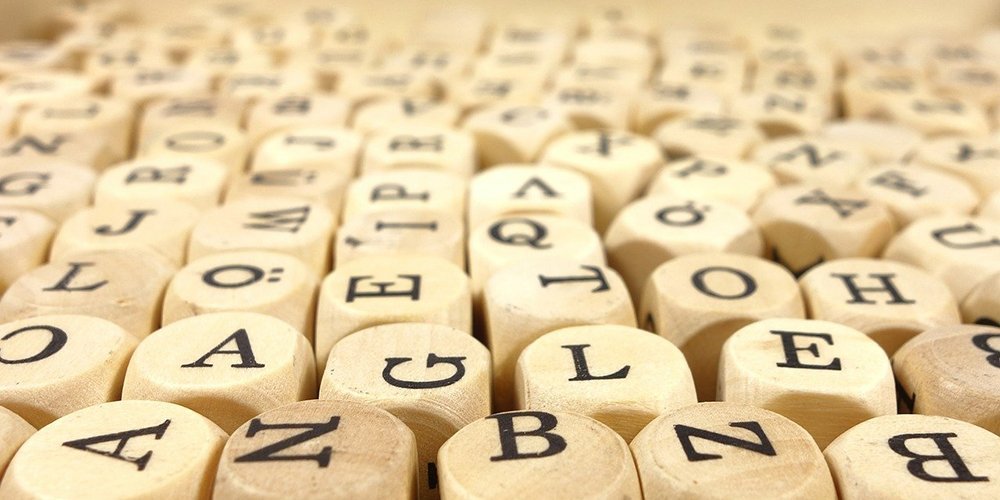
So when should they begin? Forget about age; start when it feels right, early, or late.
You can start when they’re enjoying nursery rhymes. Introduce the ABC song to them.
Add popular alphabet toys in their toy collection, and treat it like it’s any other toy they can play with. Introduce it to them and see if they take an interest in it.
Make alphabets fun by treating it like a playtime activity, and not study time. E.g., put together an alphabet puzzle and recite the letters while they’re connecting.
Gradually put alphabet charts up near their play area where they can look at the color and shape of letters.
Buying magnet alphabets and putting it up on the fridge or marker board.
Read popular alphabet books, letters that represent a word.
Go outside and write the alphabet for them to see.
Regarding alphabets, we can make a lot of things to make alphabet learning engaging and entertaining.
But What if Your Child Is Not Interested in the Alphabets?
In my opinion, I don’t see it as a big deal. If your little ones aren’t interested in the ABC’s, then they’re interested in other things.
Casually have the alphabet toys and accessories exposed.
Every kid will learn at their own pace. Forcing it while they’re not interested will just make them resist longer.
The thing that will help a lot is if they see your interest in the alphabet. You can put together an alphabet puzzle during playtime and see if your little one wants to be part of the fun. Or when you’re outside, chalking up some letters on the floor, like their name, giving them some settle exposure.
Alphabet Toys for Toddlers
ABC Books
Bright Baby colors, abc, & numbers first words
Introduces letters, number and colors
Large, colorful and sturdy format
The ABC books listed above all differ from each other, which keeps the little one engaged, while repeatedly exposing the letters to them.
ABC books technically aren’t toys, but your little one doesn’t know that. If your little one loves books, they find books just as entertaining as toys (or more).
The advantage of ABC books is that you can read to your little one the day they take their first breath.
ABC Puzzles
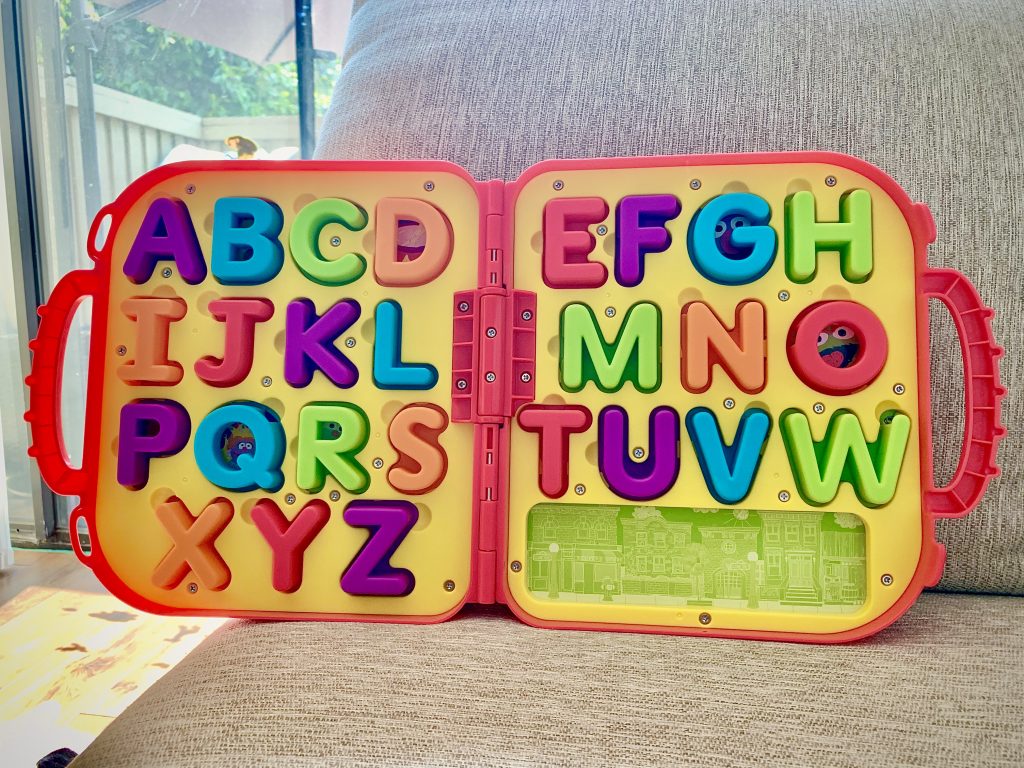
Puzzles are engaging and enjoyable. Puzzles exercise both sides of the brain, improves short-term memory, and improve problem-solving skills. Doing an alphabet puzzle will help your little one’s developing brain while learning the alphabet.
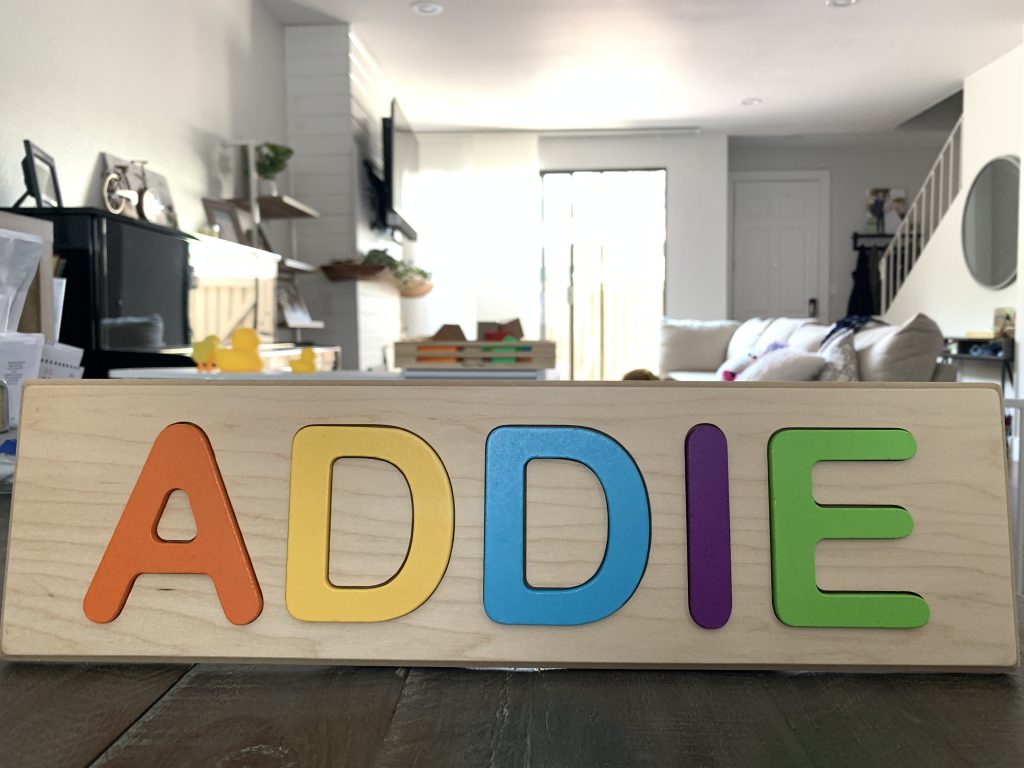
We received the puzzle with our daughter’s name from a friend. We loved playing this with her when she was getting into putting objects together. If you go on etsy.com and type in “wood letter puzzle” you can see different vendors selling custom-made name letter puzzles.
ABC Toys
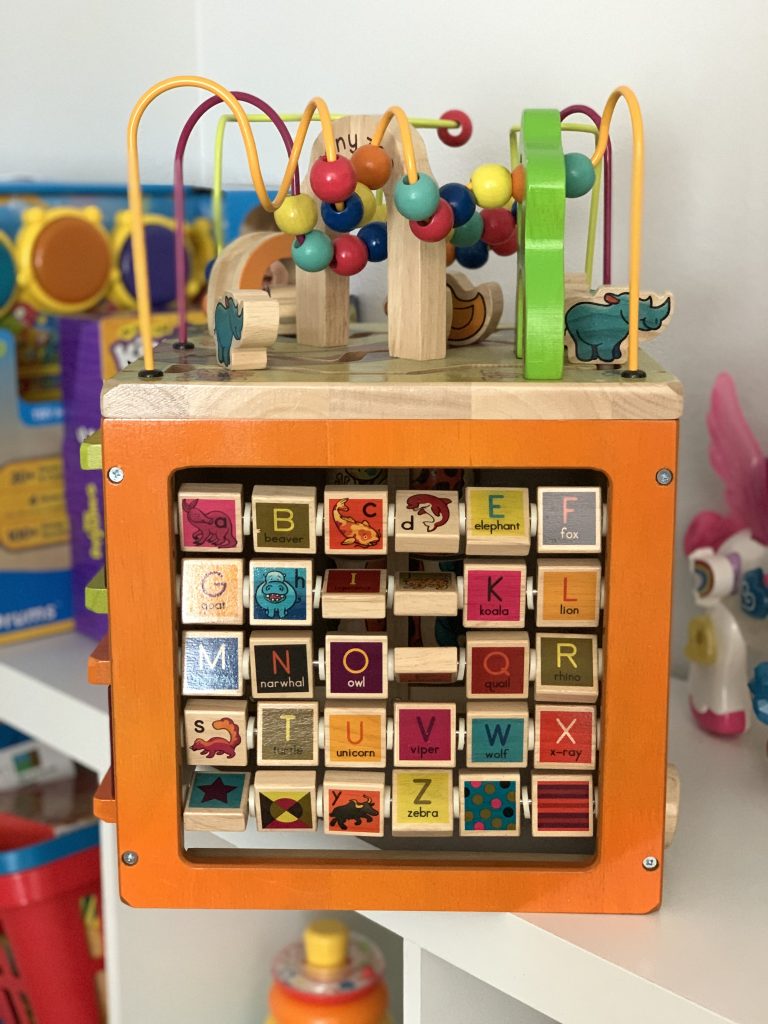
Whether you’re playing with the building blocks or activity cube, if your little one isn’t ready or show interest in alphabets, the blocks and cubes still produce an entertainment value. I would recommend these toys to teach independent play on top of learning the alphabet.
Activity blocks have various things that can promote developmental areas such as motor, sensory, and logic.
Building blocks work on fine motor skills. It also enhances a child’s problem-solving skills and mathematics.
The electronic toy recommended here is like a book in electronic form. Every letter that is pressed will pronounce the letter, display the letter, and show an image of what that letter represents (usually an animal).
The electronic toy also has games and music. This toy covers all bases if one of the ways to learn the alphabets doesn’t appeal to your little one.
ABC Magnets
MAGTiMES Magnetic Letters and Numbers
Includes: 26 uppercase letters, 60 lowercase letters,
20 numbers + 6 symbols
Munchkin Letters and Numbers Bath Toys
Shapes stick to tub walls when wet
Foam is soft, durable and non toxic
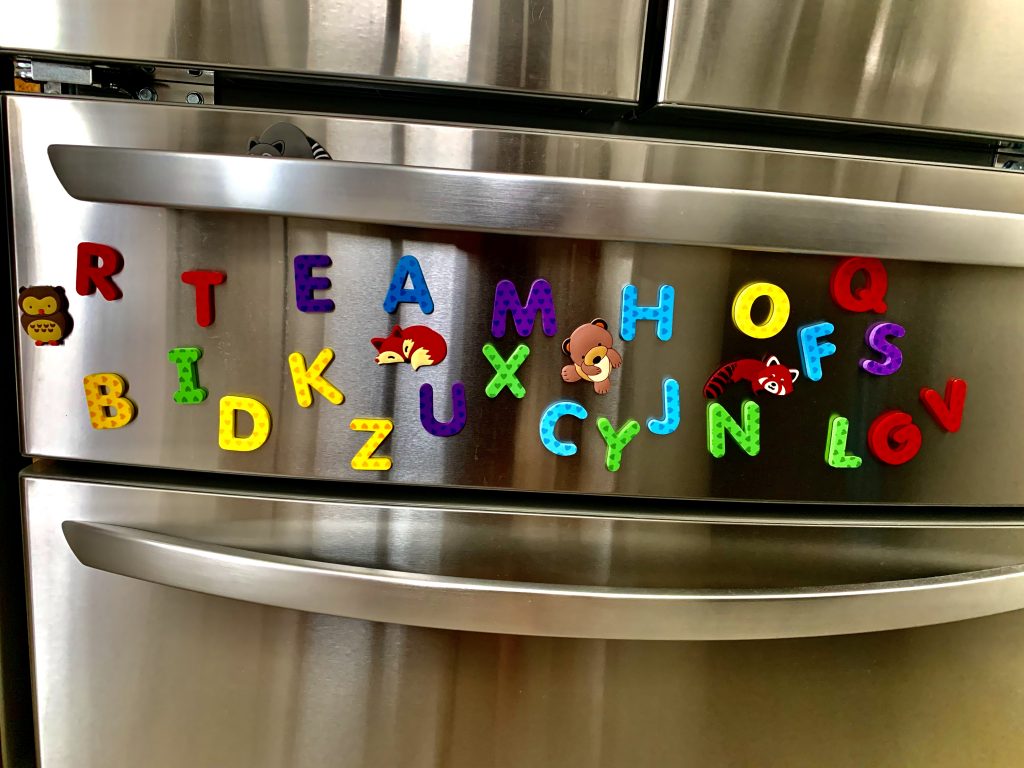
Our little one loves to mess with the magnets on the fridge. Every time she’s in the kitchen, she arranges them in a disorderly fashion. When we ask her for a specific letter, she looks at all of them, picks out the correct letter (most the time), and gives it to us.
Among her other toys in the bathtub, we make sure there are letters toys for her to play with. She likes to have her name spelled. Most of the time, she likes to rearrange them, again, in a disorderly fashion.
ABC Charts
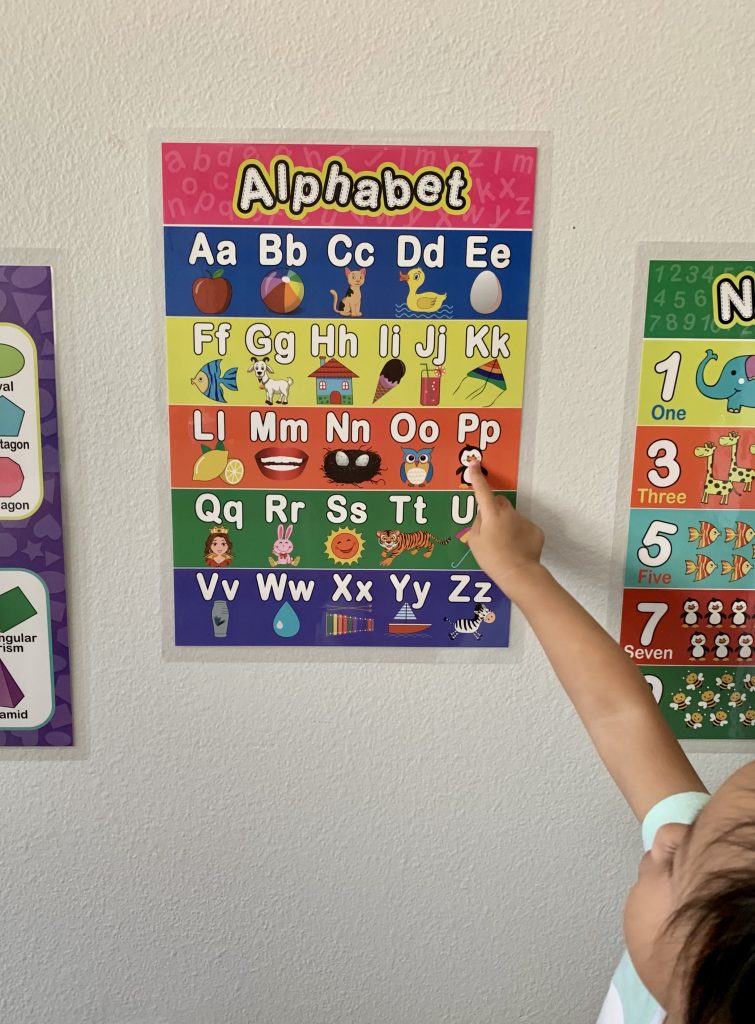
 In our case, the charts aren’t the most effective way of piquing the little one’s interest in learning the alphabet. More often than not, while she’s playing, she stops to look at the chart and recites some of the letters and colors. Then continues to go on her merry way.
In our case, the charts aren’t the most effective way of piquing the little one’s interest in learning the alphabet. More often than not, while she’s playing, she stops to look at the chart and recites some of the letters and colors. Then continues to go on her merry way.
ABC Misc
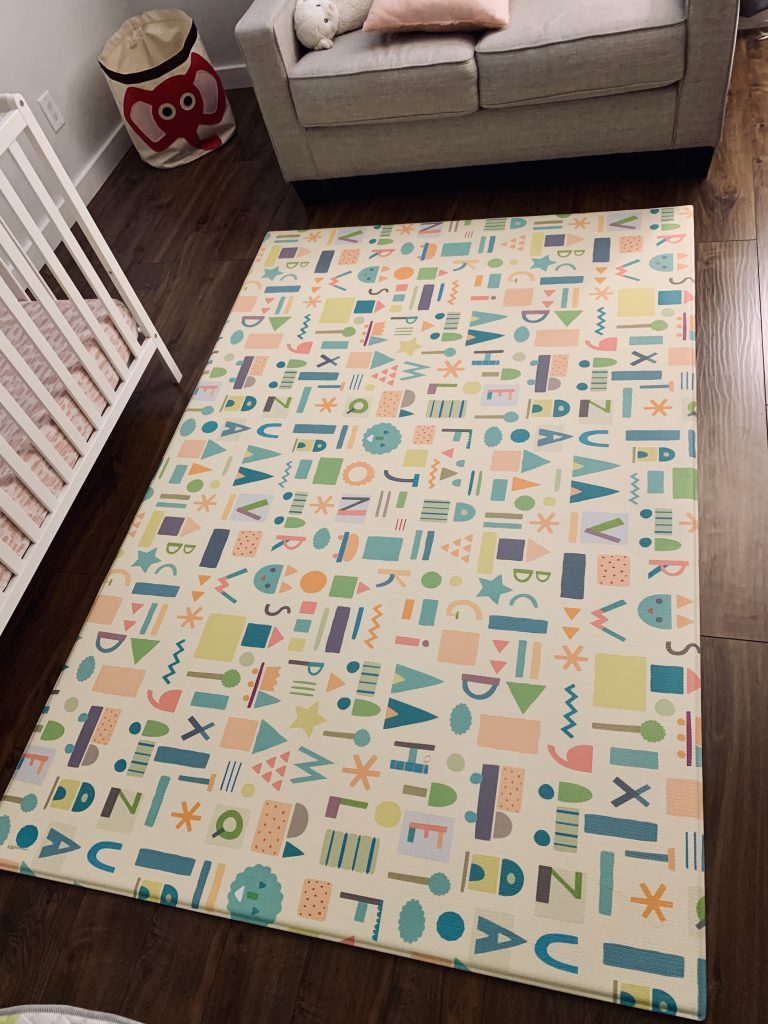
One of my favorite items that we got for our little one is a mat in her bedroom. The mat has alphabets, colors, and shapes. The item itself is well designed, and it’s a very comfortable mat to lay down on, or in her case, fall/trip on.
Before bedtime, we would play a game to find where the letters, shapes, or numbers are. Our little one gets a kick out of the game. It’s fun for her, and she’s repetitively being exposed to the alphabet.
If the household allows screen time, putting up nursery programs on YouTube like Cocomelon, Super Jojo, Little Angel, or BabyBus has the ABC song. Our little one sings along when it’s played on YouTube, and makes sure that we don’t sing along with her.
The alphabet can be taught anywhere, from the comforts of your little one’s bedroom to the outside blacktop.
Final Thoughts
“There is more than one way to skin a cat,” is a saying that fits perfectly in regards to teaching your little one the alphabet. You can sing, draw or paint, put together a puzzle, or play a game. It helps when you have the right props to assist in the learning process.
Whenever you decide to buy toys, add in some educational ones. Alphabet toys for toddlers are just like any other toys, equally entertaining and engaging.
There’s no need to force the ABCs onto your little one if they’re not ready. Don’t treat the ABC’s like academia; treat it as a play activity in your routine. Let me know if you have any other tips, tricks, or methods to learning the alphabets with toddler toys.
















